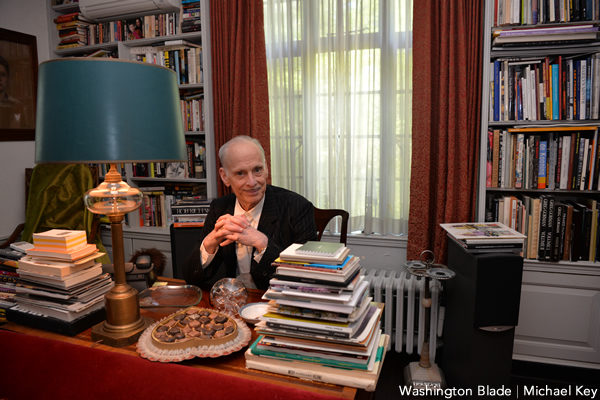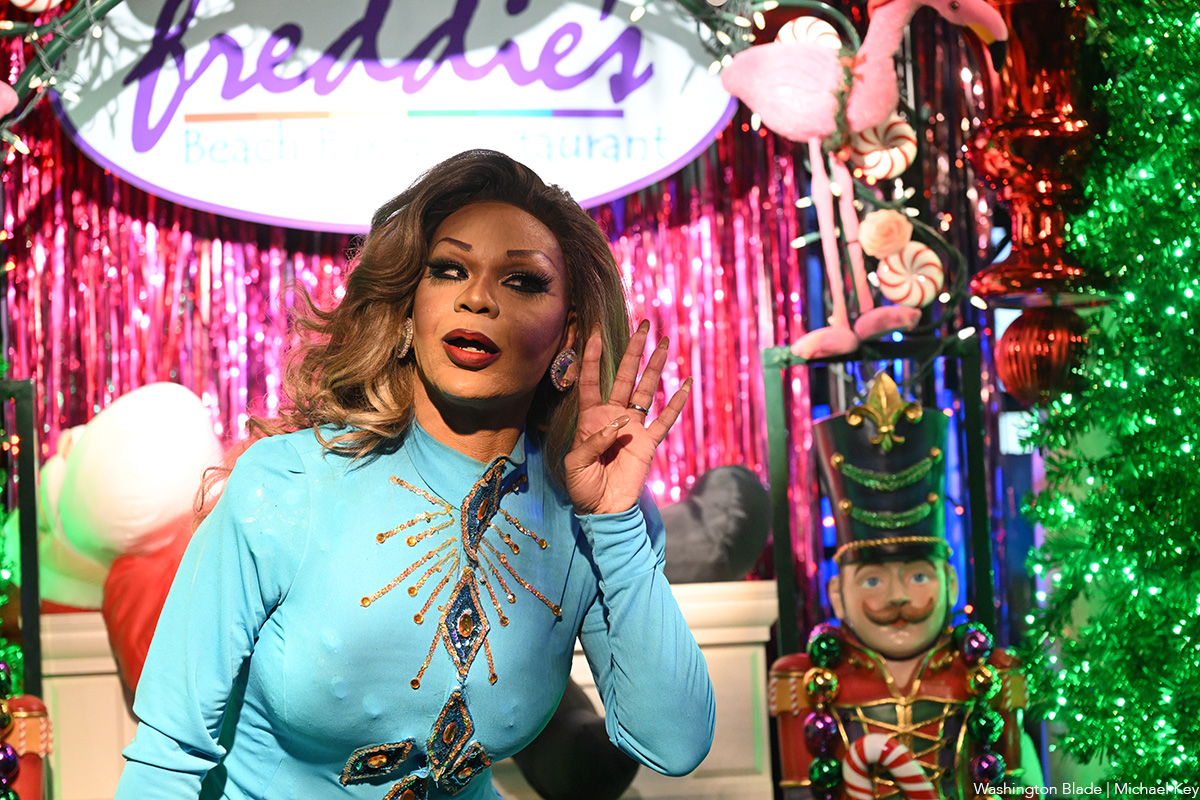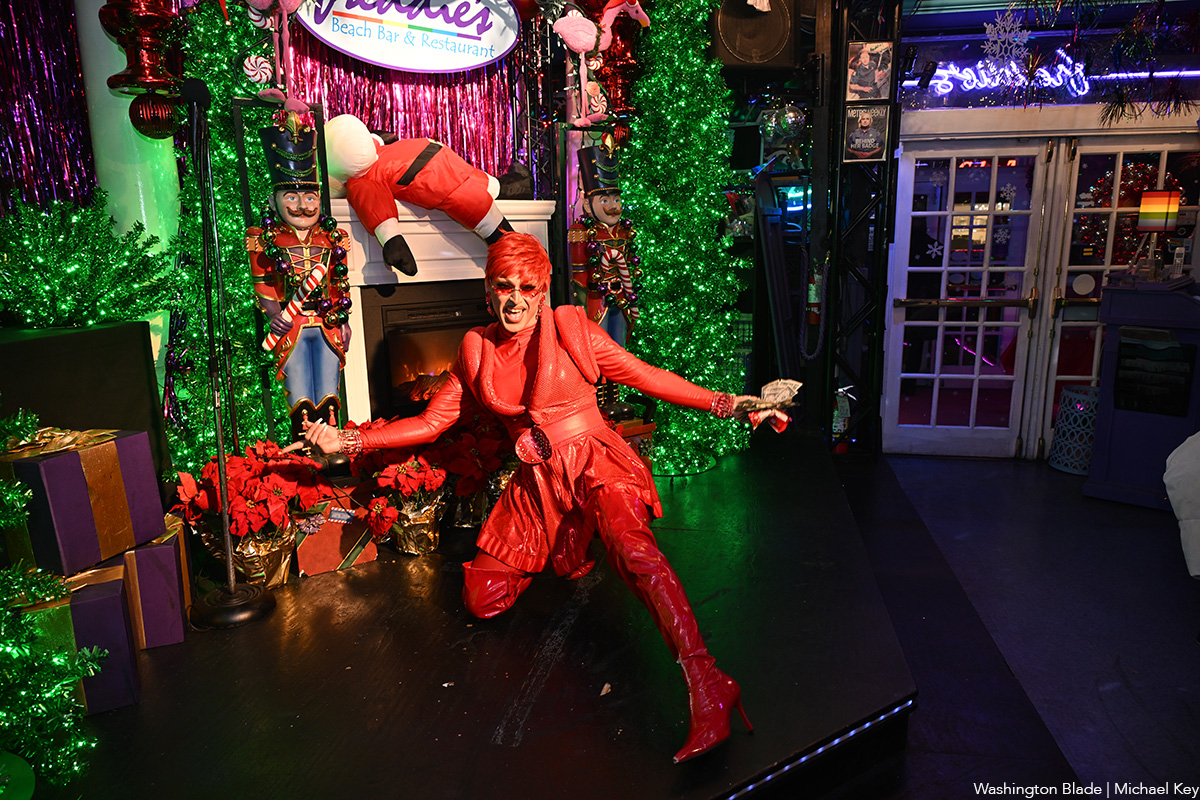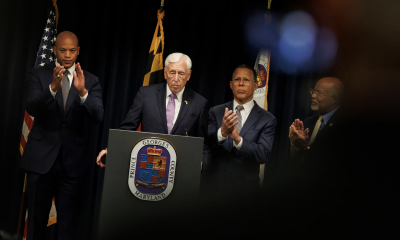Arts & Entertainment
John Waters is bringing back the drive-in — with masks — at Md. Film Festival
Will cicadas spoil the show or add to the fun?

Writer and filmmaker John Waters says he grew up going to drive-in movies.
“We went every single night. With the same movie playing.“
He had a certain routine.
“I used to…drive in alone with two cases of beer covered in a blanket and with four people in the trunk.”
Now Waters is working to introduce a new generation to drive-in movie theaters, which are making a comeback because of the COVID-19 pandemic.
“When the pandemic happened, it did bring drive-ins back,” he said in a recent interview. “Most young people have never been to a drive-in. I think it’s a good answer [to the pandemic], and it’s a good atmosphere for certain types of movies.”
Waters is getting ready to host a double feature drive-in movie night on May 21, as part of the Maryland Film Festival that runs from May 19 to May 27. The theme is “Russian Shock Night at the Drive-In,” because he selected two Russian films to present: Why Don’t You Just Die! and The Road Movie.
This will be the third time during the pandemic that Waters has hosted a drive-in night for a film festival, after double features last year for the Provincetown International Film Festival, at the Wellfleet Drive-In Theatre on Cape Cod, and the New York Film Festival, at The Bronx Zoo.
This time the venue is Druid Hill Park, home of the Maryland Zoo in Baltimore. The film festival is creating a pop-up drive-in theater on the sloping lawn of the Mansion House, the zoo’s headquarters, in conjunction with Baltimore’s Department of Recreation and Parks. It will have a 52-foot-wide inflatable screen and space for 93 vehicles. The price of admission is $25 per car, and tickets sold out in a day.
The film festival is the first organization to get a permit for an in-person outdoor gathering on public property in more than a year from the city of Baltimore, where Mayor Brandon Scott has been cautious about allowing public events. The mayor wouldn’t allow the annual July 4th fireworks show at the city’s Inner Harbor or the annual Artscape festival in July.
“I’m proud to the first one,” said Waters, who came up with the idea for a drive-in during the festival. “I’m thankful that they’re letting us do it.”
Based on his experience at the other festivals, Waters said, he’s confident it will be successful. “I love the idea of the drive-in. I think it will be good, and it is safe. Everybody’s in their car. Even if you haven’t been vaccinated. Well, I hope you don’t come if you haven’t been vaccinated. But still, everybody’s in their car. It’s at a social distance.”
Waters, who lives in Baltimore, traditionally introduces a movie of his choice on Friday night of the annual film festival, and it’s a highlight of the event. Last year it didn’t happen because the festival was cancelled due to the pandemic.
This year the festival is back as mostly a virtual event, because the theater where it’s held is still subject to COVID-related seating restrictions. Organizers asked Waters to bring back his signature movie night. He didn’t want it to be online.
“I said, I hate virtual. I’m so sick of virtual,” he recalled. “They knew I had done a drive-in at the New York Film Festival, where we showed Salo and the Gasper Noe movie, Climax…It works well in the drive In.”
Film festival organizers, led by executive director Sandra Gibson, collaborated with city officials to identify the site and figure out the details. “You don’t have to be vaccinated, but you will have to wear masks…if you’re outside your car,” Gibson said.
The parks department didn’t place a limit on the size of vehicles or the number of people in a vehicle, although larger ones will be located towards the back of the lot, she said.
“If you have a hatchback, we’ll let you open your hatchback and sit in the hatchback,” she said. “We’ll let you sit in the back of a flatbed truck as long as you have a mask on. If you have an SUV that holds eight people, we’re fine with that as long as everybody can see. But they have said you have to stay in your car.”
Waters describes Why Don’t You Just Die! as “a grindhouse, seat-ripping blood-drenched family revenge comedy that begs to be seen in a drive-in with a crazy audience cheering from their cars,” and The Road Movie as “a dash cam documentary from hell that puts you live in the car accidents and near misses all for your rage viewing pleasure.”
He said the two movies are in line with the ones he usually picks for screenings in the film festival’s Parkway Theatre, “but these two I think are even better for a drive-in setting.”
The Road Movie, featuring footage compiled from Russian dashboard cameras, has a car-oriented theme that fits with the drive-in set-up and will be the second film of the night. “You’ll drive home safely after this one, I guarantee you,” Waters said.
He chose a Russian theme, he said, “just because I loved these movies and I knew that Russia was especially kind of unmentionable these days. I’m not a fan of Russia either, but maybe everybody could come dressed as Nikita Khrushchev and his wife, or Putin.”
Given the climate in Russia, “it’s just kind of amazing that these two movies ever got made there,” he said. “They’re pretty radical movies. Especially Why Don’t You Just Die!”
Waters said the location brings back fond memories, in part because the zoo is there and he lived nearby: “I’ve always liked Druid Hill…I used to live across the street at Temple Gardens Apartments for many years.”
He jokes that he’s a little suspicious that the city permitted his event but not the Fourth of July fireworks, citing COVID-19 as the reason.
“Maybe they hope we all get it,” he said. “That’s a new one. We had the censor board. Maybe this is a different way to censor.”
He said he hopes the 17-year cicadas, insects that are just coming out of the ground in Maryland after a 17-year hiatus, make an appearance when his movies are showing.
“I wouldn’t even be mad,” he said, if they “were smashing into the windshields while we were watching. But then we should have shown The Swarm.”
Given the park setting, “you can bet there might be some,” he went on, imagining the possibilities of an insect invasion on his movie night. “It would only add to the disaster theme and the insaneness of the event, to be attacked by nature at Druid Hill Park and watching crazy Russian movies.”
According to the website DriveInMovie.com, there are about 325 drive-in movie theaters currently operating around the United States, down from a peak of more than 4,000 in the 1950s.
Besides the ones in operation, “there are many more that are permanently closed but still remain standing and could potentially be reopened at some point in the future,” says the website, which lists the drive-ins in every state and those that have closed in the past 20 years. “In fact, there have been several drive-in theaters that have been reopened the past couple of years after sitting dark for 20 or even 30 years.”
The first “true” drive-in, the website states, was the “Automobile Movie Theatre” in Camden, New Jersey. It was opened on June 6, 1933 by Richard Hollingshead, a movie buff who initially experimented with showing movies in the driveway of his home.
Hollingshead got a U. S. patent for his drive-in, which the drive-in website describes as essentially a movie screen tied to some trees, a radio placed behind the screen for sound, a film projector on the hood of a car, and a strategy for spacing out cars. His slogan was “The whole family is welcome, regardless of how noisy the children are.”
But Hollingshead’s patent was later declared invalid, and that allowed others to follow his formula without paying him royalties. “Maybe one of the reasons Drive-In Movies are so much more popular in the United States than in other countries is because the drive-in movie is truly an American invention,” the website states.
Today, both vintage drive-ins and pop-up drive-ins are being put to a variety of uses, from sites for fundraisers to filming locations to settings for socially-distanced music performances. When traditional movie theaters were shuttered because of the pandemic, drive-ins became an alternative because the audience remains outdoors.
In some cases, the land is used for swap meets and flea markets when movies aren’t being shown. Joe Biden held drive-in rallies when he was running for President, and voters applauded by honking horns and flashing headlights.
Waters, who just turned 75 and has filmed all of his movies in and around Baltimore, is a drive-in aficionado.
“I’ve spent my whole life in the drive-in,” he said. “I’ve written about them. I grew up in the Timonium Drive-In…The Bengies Drive-In, we filmed Cecil B. Demented in for a week. I spent a week on the roof of that concessions stand.”
In Polyester, “I had an art drive-in,” he said. “The joke was that they showed art movies, and in the concessions stand they had caviar and champagne. That was filmed at the Edmondson Drive-in” in Baltimore.
For him and others in his generation Waters said, the drive-in was “the first apartment’ where “kids could actually get away from their parents.”
It also taught him about saving money by sneaking people in — something he doesn’t want to see on his night.
“I’ll be catching you if you try to sneak in in the trunk, let me warn you,” he said. “I know all the tricks sneaking in the drive-in.”
For this week’s event, the plan is that Waters will be there and will be visible on screen, introducing the movies. Though he’s been vaccinated, there won’t be a Meet-and-Greet session with fans, for safety reasons. “He knows that we’ve got restrictions and he may have his own,” Gibson said. “He’s really conscious that it’s still a pandemic.”
The city has come up with a list of rules and regulations for those with tickets. Besides the requirement that people wear masks when outside the vehicle, no food or drink may be consumed outside of vehicles. Car windows must be up when eating. Tailgating isn’t allowed. Everyone must pre-register and sign a parks department waiver before arriving.
Waters said he read all the rules and couldn’t find any restrictions against having sex in a vehicle during a movie.
“I guess that means you can have sex,” he said. “When I was young, that’s what everybody did.”
The same goes for drinking in a vehicle, he said. “That’s something you always did at the drive-in too.”
The list of rules and regulations is part of the traditional drive-in experience, because every drive-in has rules. In a way, Waters said, it also goes along with the theme for the night:
“It will feel like the Russian government is watching.”
Although the drive-in night is sold out, other tickets are still available to the Maryland Film Festival, including Pride Night and eight LGBTQ-oriented films viewable online. Information about the lineup is at mdfilmfest.com.
Movies
‘Hedda’ brings queer visibility to Golden Globes
Tessa Thompson up for Best Actress for new take on Ibsen classic

The 83rd annual Golden Globes awards are set for Sunday (CBS, 8 p.m. EST). One of the many bright spots this awards season is “Hedda,” a unique LGBTQ version of the classic Henrik Ibsen story, “Hedda Gabler,” starring powerhouses Nina Hoss, Tessa Thompson and Imogen Poots. A modern reinterpretation of a timeless story, the film and its cast have already received several nominations this awards season, including a Globes nod for Best Actress for Thompson.
Writer/director Nia DaCosta was fascinated by Ibsen’s play and the enigmatic character of the deeply complex Hedda, who in the original, is stuck in a marriage she doesn’t want, and still is drawn to her former lover, Eilert.
But in DaCosta’s adaptation, there’s a fundamental difference: Eilert is being played by Hoss, and is now named Eileen.
“That name change adds this element of queerness to the story as well,” said DaCosta at a recent Golden Globes press event. “And although some people read the original play as Hedda being queer, which I find interesting, which I didn’t necessarily…it was a side effect in my movie that everyone was queer once I changed Eilert to a woman.”
She added: “But it still, for me, stayed true to the original because I was staying true to all the themes and the feelings and the sort of muckiness that I love so much about the original work.”
Thompson, who is bisexual, enjoyed playing this new version of Hedda, noting that the queer love storyline gave the film “a whole lot of knockoff effects.”
“But I think more than that, I think fundamentally something that it does is give Hedda a real foil. Another woman who’s in the world who’s making very different choices. And I think this is a film that wants to explore that piece more than Ibsen’s.”
DaCosta making it a queer story “made that kind of jump off the page and get under my skin in a way that felt really immediate,” Thompson acknowledged.
“It wants to explore sort of pathways to personhood and gaining sort of agency over one’s life. In the original piece, you have Hedda saying, ‘for once, I want to be in control of a man’s destiny,’” said Thompson.
“And I think in our piece, you see a woman struggling with trying to be in control of her own. And I thought that sort of mind, what is in the original material, but made it just, for me, make sense as a modern woman now.”
It is because of Hedda’s jealousy and envy of Eileen and her new girlfriend (Poots) that we see the character make impulsive moves.
“I think to a modern sensibility, the idea of a woman being quite jealous of another woman and acting out on that is really something that there’s not a lot of patience or grace for that in the world that we live in now,” said Thompson.
“Which I appreciate. But I do think there is something really generative. What I discovered with playing Hedda is, if it’s not left unchecked, there’s something very generative about feelings like envy and jealousy, because they point us in the direction of self. They help us understand the kind of lives that we want to live.”
Hoss actually played Hedda on stage in Berlin for several years previously.
“When I read the script, I was so surprised and mesmerized by what this decision did that there’s an Eileen instead of an Ejlert Lovborg,” said Hoss. “I was so drawn to this woman immediately.”
The deep love that is still there between Hedda and Eileen was immediately evident, as soon as the characters meet onscreen.
“If she is able to have this emotion with Eileen’s eyes, I think she isn’t yet because she doesn’t want to be vulnerable,” said Hoss. “So she doesn’t allow herself to feel that because then she could get hurt. And that’s something Eileen never got through to. So that’s the deep sadness within Eileen that she couldn’t make her feel the love, but at least these two when they meet, you feel like, ‘Oh my God, it’s not yet done with those two.’’’
Onscreen and offscreen, Thompson and Hoss loved working with each other.
“She did such great, strong choices…I looked at her transforming, which was somewhat mesmerizing, and she was really dangerous,” Hoss enthused. “It’s like when she was Hedda, I was a little bit like, but on the other hand, of course, fascinated. And that’s the thing that these humans have that are slightly dangerous. They’re also very fascinating.”
Hoss said that’s what drew Eileen to Hedda.
“I think both women want to change each other, but actually how they are is what attracts them to each other. And they’re very complimentary in that sense. So they would make up a great couple, I would believe. But the way they are right now, they’re just not good for each other. So in a way, that’s what we were talking about. I think we thought, ‘well, the background story must have been something like a chaotic, wonderful, just exploring for the first time, being in love, being out of society, doing something slightly dangerous, hidden, and then not so hidden because they would enter the Bohemian world where it was kind of okay to be queer and to celebrate yourself and to explore it.’”
But up to a certain point, because Eileen started working and was really after, ‘This is what I want to do. I want to publish, I want to become someone in the academic world,’” noted Hoss.
Poots has had her hands full playing Eileen’s love interest as she also starred in the complicated drama, “The Chronology of Water” (based on the memoir by Lydia Yuknavitch and directed by queer actress Kristen Stewart).
“Because the character in ‘Hedda’ is the only person in that triptych of women who’s acting on her impulses, despite the fact she’s incredibly, seemingly fragile, she’s the only one who has the ability to move through cowardice,” Poots acknowledged. “And that’s an interesting thing.”
Arts & Entertainment
2026 Most Eligible LGBTQ Singles nominations
We are looking for the most eligible LGBTQ singles in the Washington, D.C. region.

Are you or a friend looking to find a little love in 2026? We are looking for the most eligible LGBTQ singles in the Washington, D.C. region. Nominate you or your friends until January 23rd using the form below or by clicking HERE.
Our most eligible singles will be announced online in February. View our 2025 singles HERE.

The Freddie’s Follies drag show was held at Freddie’s Beach Bar in Arlington, Va. on Saturday, Jan. 3. Performers included Monet Dupree, Michelle Livigne, Shirley Naytch, Gigi Paris Couture and Shenandoah.
(Washington Blade photos by Michael Key)










-

 Sponsored4 days ago
Sponsored4 days agoSafer Ways to Pay for Online Performances and Queer Events
-

 District of Columbia3 days ago
District of Columbia3 days agoTwo pioneering gay journalists to speak at Thursday event
-

 Colombia3 days ago
Colombia3 days agoBlade travels to Colombia after U.S. forces seize Maduro in Venezuela
-

 a&e features3 days ago
a&e features3 days agoQueer highlights of the 2026 Critics Choice Awards: Aunt Gladys, that ‘Heated Rivalry’ shoutout and more


















